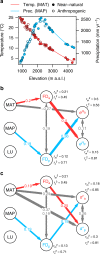Plant and animal functional diversity drive mutualistic network assembly across an elevational gradient
- PMID: 30093613
- PMCID: PMC6085337
- DOI: 10.1038/s41467-018-05610-w
Plant and animal functional diversity drive mutualistic network assembly across an elevational gradient
Abstract
Species' functional traits set the blueprint for pair-wise interactions in ecological networks. Yet, it is unknown to what extent the functional diversity of plant and animal communities controls network assembly along environmental gradients in real-world ecosystems. Here we address this question with a unique dataset of mutualistic bird-fruit, bird-flower and insect-flower interaction networks and associated functional traits of 200 plant and 282 animal species sampled along broad climate and land-use gradients on Mt. Kilimanjaro. We show that plant functional diversity is mainly limited by precipitation, while animal functional diversity is primarily limited by temperature. Furthermore, shifts in plant and animal functional diversity along the elevational gradient control the niche breadth and partitioning of the respective other trophic level. These findings reveal that climatic constraints on the functional diversity of either plants or animals determine the relative importance of bottom-up and top-down control in plant-animal interaction networks.
Conflict of interest statement
The authors declare no competing interests.
Figures



References
-
- Bascompte J, Jordano P. Plant-animal mutualistic networks: the architecture of biodiversity. Annu. Rev. Ecol. Evol. Syst. 2007;38:567–593. doi: 10.1146/annurev.ecolsys.38.091206.095818. - DOI
Publication types
MeSH terms
Grants and funding
- For1246/Deutsche Forschungsgemeinschaft (German Research Foundation)/International
- FOR1246/Deutsche Forschungsgemeinschaft (German Research Foundation)/International
- FOR1246/Deutsche Forschungsgemeinschaft (German Research Foundation)/International
- FOR1246/Deutsche Forschungsgemeinschaft (German Research Foundation)/International
- FOR1246/Deutsche Forschungsgemeinschaft (German Research Foundation)/International
- FOR1246/Deutsche Forschungsgemeinschaft (German Research Foundation)/International
- FOR1246/Deutsche Forschungsgemeinschaft (German Research Foundation)/International
- FOR1246/Deutsche Forschungsgemeinschaft (German Research Foundation)/International
- FOR1246/Deutsche Forschungsgemeinschaft (German Research Foundation)/International
- FOR1246/Deutsche Forschungsgemeinschaft (German Research Foundation)/International
- FOR1246/Deutsche Forschungsgemeinschaft (German Research Foundation)/International
- FOR1246/Deutsche Forschungsgemeinschaft (German Research Foundation)/International
- FOR1246/Deutsche Forschungsgemeinschaft (German Research Foundation)/International
- FOR1246/Deutsche Forschungsgemeinschaft (German Research Foundation)/International
LinkOut - more resources
Full Text Sources
Other Literature Sources

